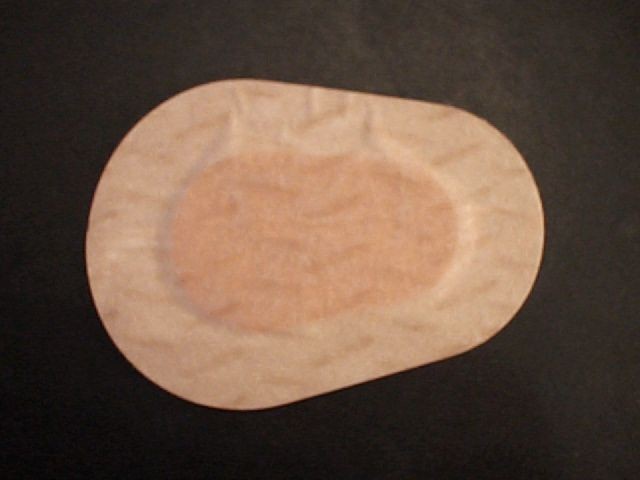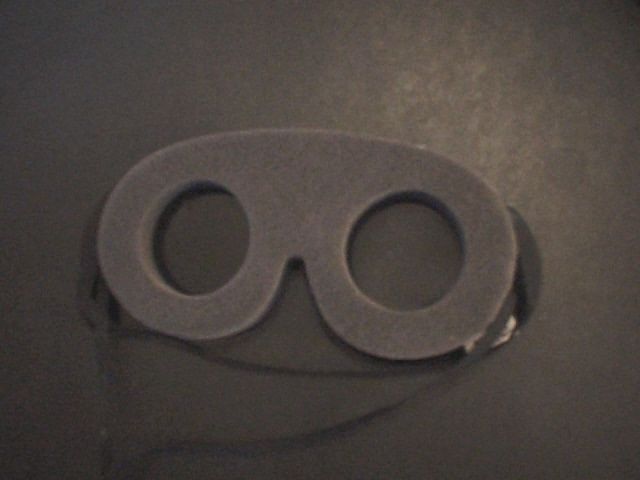

This is the top of the eye patch - the part that faces away from the eye. You can see in the center the padding that goes over the eyelid.
This is the bottom part, with the paper backing still in place.
Simulating Blindness
Over the last couple of years, I have found several ways to simulate the loss (or at least near-loss) of vision. The best method I have found is by using adhesive ophthalmic eye patches. These patches are most often used to treat "lazy eye" - a condition of the muscles that control the movements of the eye.
These patches work by gently holding the eyelid closed, and limiting the amount of light that can reach the covered eye. In normal use, these patches are only worn on one eye, but for our purposes, we will of course use two!
Properly placed, these eye patches are quite comfortable and can be worn for extended periods of time. 12 hours or more is not a problem, but comfort should be your guide.
|
|
|
|
This is the top of the eye patch - the part that faces away from the eye. You can see in the center the padding that goes over the eyelid. |
This is the bottom part, with the paper backing still in place. |
Applying eye patches
There are two ways to apply these patches.
The first allows the eyelid to open and close freely. The advantage of this method is that the eye pads may be worn for as long as you like - a day would not be unreasonable at all. The disadvantages are that some of the effect is lost, as you can still "see" the inside of the pad, and second, there is sometimes an eyelash that can come off inside the patch, and bother the eye.
The second method holds the eyelid closed. The advantage of this method is that it limits vision much more completely. Since the eye cannot be opened, it becomes possible only to sense the presence of light - but not to tell how bright it is, or where it is coming from. The disadvantage is that you really should not wear the pad for more than 12 hours like this, as the eye can become irritated.
Method 1: Apply the eye patch so the central pad is not pressing against the eyelid. Attaching the adhesive areas slightly outside of the eye area can do this.
Method 2: while keeping the eye relaxed and closed, apply the patch directly over the eyelid. Begin at the top, pressing the pad gently into the area at the very top of the eye, and work your way down, pressing the pad against the eyelid at all times.
In either case, the eye patches prevent you from seeing, and allow you to try navigating without use of your eyes. I prefer using them to a typical blindfold for two reasons. First, it takes some effort to remove them. Second, if worn under a pair of sunglasses, these flesh-colored bandages are virtually unnoticeable to the casual observer. Yes, you will be able to detect the presence of light, but it will be of no use to you.

Another method of simulating blindness - and in some ways more effective - is through using a good blindfold. One that I have found to work very well is a sleep mask, which can be found at "Sharper Image" stores, called a Mindfold. With a completely black eye cover, and foam padding on the inside, even bright light simply does not get through this blindfold.
As you can see from this picture, there are cutouts for the eyes, so there is no pressure against them at all. In an average room, you will sense no light at all.
The only drawbacks to a blindfold such as this are that it is too easy (and tempting) to remove, should you become disoriented and want to be able to see, and it would look pretty funny in a public setting.
"Goggles" blindfold
A regular pair of swimming goggles, coated on the inside with "tool dip", makes for an amazingly effective and fairly comfortable blindfold. In addition, it can be worn while showering, in the backyard pool, and so on. This is probably not comfortable enough to be worn for many hours at a time, but a good compromise nonetheless. This blindfold was suggested by a visitor to this page (you know who you are!)
|
|
|
|
View from the outside of the goggles. These ones were tinted to begin with, so the appearance is actually quite neat and "finished" looking. |
Inside the eyepiece. You may be able to see the coating of rubber on the inside. These are completely BLACK when you put them on - there is no light at all. |
I got the goggles from Wal-Mart for about $7. "Tool Dip" can be obtained at any good hardware store for about $4-6. I recommend black, though you might like something else.
Sources for eye patches: The two brands that I am aware of are "Coverlet", and 3M. I prefer the Coverlet patches because they are more flexible, and the light-blocking of the center pad makes for a more complete effect. These eye pads can be found at most larger drug stores.
Return to my home page